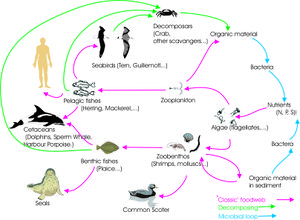Difference between revisions of "Pollution and the food web"
| Line 7: | Line 7: | ||
The different components of the ecosystem demonstrate a different vulnerability for certain pollutants. Pollutants can [[bioaccumulation|bioaccumulate]] when they are ingested at a higher rate than excreted. Pollutants which bioacumulate can also [[biomagnification|biomagnify]] if the pollutant is accumulated at all levels of the [[food chain]]. Biomagnifiyng substances are typically lipophilic (meaning they tend to dissolve in fat rather than water), like [[organochlorine compounds|organonochlorines]], or have a high affinity for proteins, like [[methylmercury]]. Pollutants which are mostly water associated, like [[heavy metals]], don't tend to biomagnify. The latter may however bioaccumulate to very high concentrations in some organisms. | The different components of the ecosystem demonstrate a different vulnerability for certain pollutants. Pollutants can [[bioaccumulation|bioaccumulate]] when they are ingested at a higher rate than excreted. Pollutants which bioacumulate can also [[biomagnification|biomagnify]] if the pollutant is accumulated at all levels of the [[food chain]]. Biomagnifiyng substances are typically lipophilic (meaning they tend to dissolve in fat rather than water), like [[organochlorine compounds|organonochlorines]], or have a high affinity for proteins, like [[methylmercury]]. Pollutants which are mostly water associated, like [[heavy metals]], don't tend to biomagnify. The latter may however bioaccumulate to very high concentrations in some organisms. | ||
| − | [[biomagnification|Biomagnifying]] compounds usually affect the top of the ecosystem ([[pollution and sea birds|sea birds]], [[pollution and marine mammals|marine mammals]], [[pollution and pelagic fishes|fishes]],...) most, because that's where they reach the highest levels. Filter feeds, such as bivalves, usually have high bioacumulation rates because they acquire large amounts of pollutants from suspended particles. Pollutants with a low water solubility tend to be [[adsorption|adsorbed]] to particles. | + | [[biomagnification|Biomagnifying]] compounds usually affect the top of the ecosystem ([[pollution and sea birds|sea birds]], [[pollution and marine mammals|marine mammals]], [[pollution and pelagic fishes|fishes]],...) most, because that's where they reach the highest levels. Compounds which don't biomagnify will first affect species with a low tolerance and those who accumulate lots of them. Juvenile stages have been shown to be particularly sensitive towards many pollutants. Filter feeds, such as bivalves, usually have high bioacumulation rates because they acquire large amounts of pollutants from suspended particles. Pollutants with a low water solubility tend to be [[adsorption|adsorbed]] to particles. These particles also tend to sink to the bottom, causing sediments to have a high pollutant content. |
| − | |||
| − | |||
| − | |||
| + | Below you can find some Belgian case studies of ecotoxicologic substances through the food web | ||
== Case studies == | == Case studies == | ||
Revision as of 13:18, 28 July 2009
Oceans receive pollutants from the atmosphere and from riverine inflow. Coastal environments are more likely to be affected because they can receive pollutants from both sources. They are also less deep and can receive secondary contaminations from pollutants which were stored in the sediments. Particularly coastal areas near industrialized and highly populated areas can contain high concentrations of pollutants. If these areas have a limited mixing with water from the open ocean, like the Baltic sea, the ecosystem becomes extremely vulnerable.
The different components of the ecosystem demonstrate a different vulnerability for certain pollutants. Pollutants can bioaccumulate when they are ingested at a higher rate than excreted. Pollutants which bioacumulate can also biomagnify if the pollutant is accumulated at all levels of the food chain. Biomagnifiyng substances are typically lipophilic (meaning they tend to dissolve in fat rather than water), like organonochlorines, or have a high affinity for proteins, like methylmercury. Pollutants which are mostly water associated, like heavy metals, don't tend to biomagnify. The latter may however bioaccumulate to very high concentrations in some organisms.
Biomagnifying compounds usually affect the top of the ecosystem (sea birds, marine mammals, fishes,...) most, because that's where they reach the highest levels. Compounds which don't biomagnify will first affect species with a low tolerance and those who accumulate lots of them. Juvenile stages have been shown to be particularly sensitive towards many pollutants. Filter feeds, such as bivalves, usually have high bioacumulation rates because they acquire large amounts of pollutants from suspended particles. Pollutants with a low water solubility tend to be adsorbed to particles. These particles also tend to sink to the bottom, causing sediments to have a high pollutant content.
Below you can find some Belgian case studies of ecotoxicologic substances through the food web
Case studies
Case study 1: PBDE through the entire North Sea food web[1]
References
- ↑ Boon, J.P.; Lewis, W.E.; Tjoen-A-Choy, M.R.; Allchin, C.R.; Law, R.J.; de Boer, J.; Hallers-Tjabbes, C.C.; Zegers, B.N. (2002). Levels of polybrominated diphenyl ether (PBDE) flame retardants in animals representing different trophic levels of the North Sea food web. Environ. Sci. Technol. 36(19): 4025-4032
